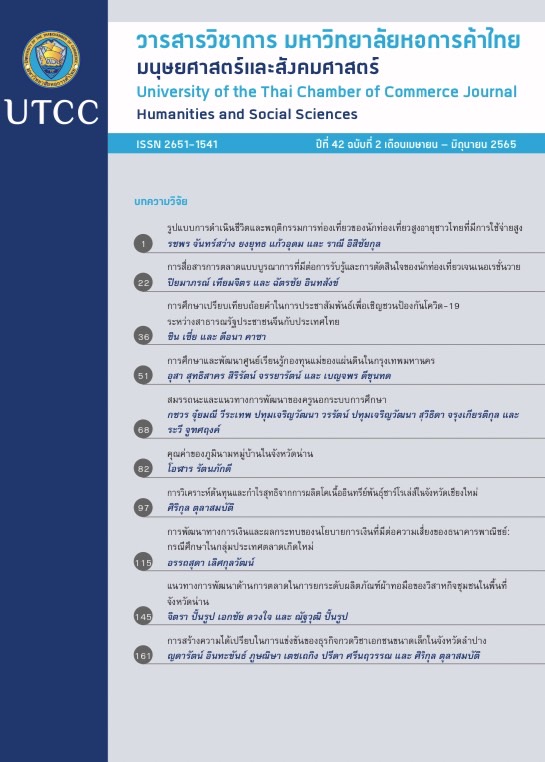Marketing Development for Enhancing Hand-Woven Fabric Products of Community Enterprise, Nan Province
Main Article Content
Abstract
The purpose of this research was to develop marketing factors for enhancing hand-woven fabric products of community enterprises in Nan province. The sample groups used in this research consisted of 2 groups. The first group was 400 customers. The second group is 100 members of community enterprises. These mixed methods combined quantitative and qualitative research. The result from SWOT analysis was found that the hand-woven fabric products of community enterprises have a strength for beautiful designs that are unique according to the local wisdom. The weakness is that the product can be easily imitated. The opportunity is the high tourism potential in Nan province, a special area for tourism. The threat is that the price of raw materials is constantly rising, causing high production costs. The analysis’s result of CFA indicated that the four factors including satisfaction, perceived value, trust, and integrated marketing communication could be interpreting 90.674% of variance. Moreover, the consistency of the model in each component was tested. The analysis’s result of CFA proves that the development model was validated the empirical data due to the comprised indicators. For product development guidelines, community enterprises should do the following: 1) product design and packaging should be developed in modern style and outstanding 2) product price should be set to penetrate the market to stimulate sales and 3) distribution channels should have multiple channels for customers to easily reach and focus on selling as souvenirs for tourists as well as continual advertising and public relations.
Article Details

This work is licensed under a Creative Commons Attribution-NonCommercial-NoDerivatives 4.0 International License.
ลิขสิทธิ์ของบทความ
ผลงานที่ได้รับการตีพิมพ์ถือเป็นลิขสิทธิ์ของมหาวิทยาลัยหอการค้าไทย ห้ามมิให้นำเนื้อหา ทัศนะ หรือข้อคิดเห็นใด ๆ ของผลงานไปทำซ้ำ ดัดแปลง หรือเผยแพร่ ไม่ว่าทั้งหมดหรือบางส่วนโดยไม่ได้รับอนุญาตเป็นลายลักษณ์อักษรจากมหาวิทยาลัยหอการค้าไทยก่อน
References
กัญญาวีร์ อินทร์สันต์ และบุษกรณ์ ลีเจ้ยวะระ. (2563). การสื่อสารการตลาดแบบบูรณาการ และการสื่อสารการตลาดแบบปากต่อปาก ผ่านสื่ออิเล็กทรอนิกส์ที่มีผลต่อการตัดสินใจซื้อสินค้าของลูกค้าร้านค้าปลีกแบบดั้งเดิม ในเขตจังหวัดกาฬสินธุ์. วารสารวิชาการและวิจัยมหาวิทยาลัยภาคตะวันออกเฉียงเหนือ, 10(3), 79-91.
กุลชลี พวงเพ็ชร์, สมพร พวงเพ็ชร์, และโสพิศ คำนวนชัย. (2561). แนวทางการพัฒนาด้านการตลาดธุรกิจไข่เค็มใบเตย: กรณีศึกษาวิสาหกิจชุมชนกลุ่มแม่บ้านเกษตรกรบ้านโคกพุทรา หมู่ที่ 2 ตำบลถนนใหญ่ อำเภอเมือง จังหวัดลพบุรี. Veridian E-Journal, Silpakorn University สาขามนุษยศาสตร์ สังคมศาสตร์ และศิลปะ, 11(2), 1440-1454.
พิมพ์พิสุทธิ์ ศรีมณีสวัสดิ์, วรรณภา ประนาเส, ณัฐริกา ลุงไธสง์, พรพิมล ตงทอง, สุพัตรา รักการศิลป์, และผกามาศ มูลวันดี. (2561). การวิเคราะห์ต้นทุนและผลตอบแทนจากการทอผ้าซิ่นตีนแดงด้วยเส้นด้ายประดิษฐ์ ของชุมชนบ้านคูบอน ตําบลคูเมือง อําเภอคูเมือง จังหวัดบุรีรัมย์. วารสารวิจัยและพัฒนา มหาวิทยาลัยราชภัฏบุรีรัมย์, 13(1), 95-103.
อัจฉรา เมฆสุวรรณ, บุญฑวรรณ วิงวอน, และจตุพร สังขวรรณ. (2559). อิทธิพลของทุนทางปัญญาความสามารถทางการตลาดและการมีส่วนร่วมที่มีต่อผลการดำเนินงานของวิสาหกิจชุมชนประเภทหัตถกรรมกลุ่มผ้าทอมือภาคเหนือตอนบนของประเทศไทย. วารสารวิชาการเครือข่ายบัณฑิตศึกษามหาวิทยาลัยราชภัฏภาคเหนือ, 6(11), 111-124.
Birkenmeier, B. J., & Sanséau, P. (2016). The relationships between perceptions of supervisor, trust in supervisor and job performance: A study in the banking industry. Journal of Applied Business Research, 32(1), 150-161.
Dash, G., Kiefer, K., & Paul, J. (2021). Marketing-to-Millennials: Marketing 4.0, customer satisfaction and purchase intention. Journal of Business Research, 122, 608-620.
Irshad, M., Ahmad, M. S., & Malik, O. F. (2020). Understanding consumers' trust in social media marketing environment. International Journal of Retail & Distribution Management, 48(11), 1195-1212.
Kotler, P. (2003). Marketing management (11thed.). Upper Saddle River, NJ: Prentice Hall.
Kotler, P., & Keller, K. (2009). Marketing management (13th ed.). Upper Saddle River, NJ: Pearson Prentice Hall.
Lam, S. Y., Shankar, V., Erramilli, M. K., & Murthy, B. (2004). Customer value, satisfaction, loyalty, and switching costs: An illustration from a business-to-business service context. Journal of the Academy of Marketing Science, 32(3), 293-311.
Mandal, P. C. (2021). Public policy issues and technoethics in marketing research in the Digital Age. International Journal of Technoethics, 12(1), 75-86.
Mencarelli, R., & Lombart, C. (2017). Influences of the perceived value on actual repurchasing behavior: Empirical exploration in a retailing context. Journal of Retailing and Consumer Services, 38, 12-21.
Morgan, R.M., & Hunt, S.D. (1994). The commitment trust theory of relationship marketing. Journal of Marketing, 58(3), 20-38.
Pergelova, A., Prior, D., & Rialp, J. (2008). Marketing communication efficiency in the Spanish automobile sector: Analysing the role of online advertising through DEA and stochastic frontiers. Academia-Revista Latinoamericana De Administracion, 41, 91-107.
Sánchez, J., Callarisa, L., Rodríguez, R. M., & Moliner, M. A. (2006). Perceived value of the purchase of a tourism product. Tourism Management, 27(3), 394-409.
Schultz, D.E., Gayle, K. C., & PattiandIlchul, K. (2008). An inside-out approach to integrated marketing communication. International Journal of Advertising, 27(4), 511-548.
Seric, M., & Mikulic, J. (2020). Building brand equity through communication consistency in luxury hotels: an impact-asymmetry analysis. Journal of Hospitality and Tourism Insights, 3(4), 451-468.
Tariq, B., Taimoor, S., Najam, H., Law, R., Hassan, W., & Han, H. (2020). Generating marketing outcomes through Internet of Things (IoT) technologies. Sustainability, 12(22), 51-58.
Zanon, J., Scholl-Grissemann, U., Kallmuenzer, A., Kleinhansl, N., & Peters, M. (2019). How promoting a family firm image affects customer perception in the age of social media. Journal of Family Business Strategy, 10(1), 28-37.


